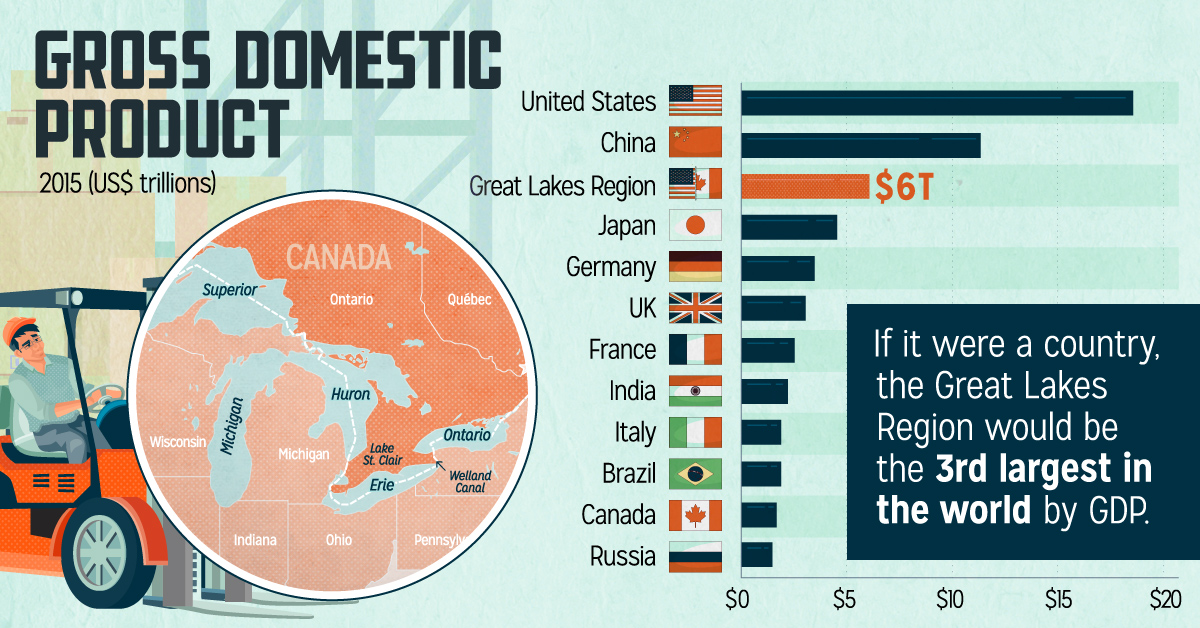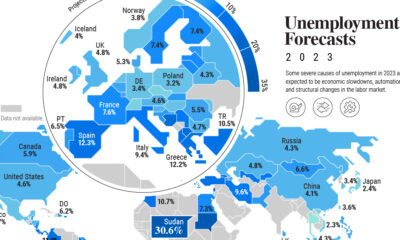After all, the region is tightly integrated in terms of trade. It alone accounts for more than 50% of all U.S./Canadian bilateral border trade and sees over 200 million tons of cargo shipped annually. If it were its own country, it would have a GDP of US$6 trillion – making it the third biggest economy in the world.
An Economic Powerhouse
Today’s infographic comes from the Council of the Great Lakes Region, and it breaks down the massive economic impact and trade partnerships that stem from the region’s prolific waterways, and the people living around them.
The Great Lakes Region has always been a center of trade. From the fur trade of the 17th century to modern day, the area’s navigable terrain, waterways, and ports have made it an easy place for goods to exchange hands.
Overview: The Great Lakes Economy
The Great Lakes Region includes eight states (Minnesota, Wisconsin, Illinois, Indiana, Michigan, New York, Ohio, and Pennsylvania) and two Canadian provinces (Ontario and Quebec) that surround the five interconnected freshwater bodies known as the Great Lakes. The area is home to 107 million people, 51 million jobs, and a GDP of US$6 trillion – making the Great Lakes Economy a powerhouse on an international level. In particular, the region is well-known globally for its manufacturing prowess. It’s home to automobile and aerospace giants like Ford, GM, Chrysler, Bombardier, GE Aviation, and Magna International, and also many other diverse industries. Education and health, shipping and logistics, agriculture, mining and energy, tourism, and finance are some of the other major industries that generate business for the region. And despite having a border, the Great Lakes Economy is highly integrated. Each year, there is $278 billion in bilateral U.S.-Canadian trade in the Great Lakes area – more than the entire region trades with countries like Mexico, China, UK, Germany and Japan combined.
Cross-Border Customers
The relationship between U.S. states and Canadian provinces in the Great Lakes Region is unique, and relies on goods flowing both ways. For U.S. companies in the region, 78% of the imports they bring in from Canada are “intermediate goods”, which are raw materials, parts and components, and services that are used to produce other goods and services in the United States. Here’s a breakdown of Canadian intermediate goods bought by U.S. states: Going the other way, Canadians buy billions of dollars worth of goods from the Great Lake states as well. In fact, Canada is actually the biggest international customer for each state in the region – something we’ve previously shown in our USA/Canada trade infographic as well.
Bridge Over Troubled Water
Although rhetoric against the U.S./Canadian trade relationship has ramped up in the recent months, there is still one enduring symbol that exemplifies the intimate trade relationship of the two countries in the Great Lakes Economy: the Ambassador Bridge between Detroit, Michigan and Windsor, Ontario. Each day, over this one 1.3 mi (2.3 km) suspension bridge alone, close to 10,000 trucks pass to generate close to US$500 million of international trade between the two nations. That’s equal to 25% of all bilateral trade between Canada and the U.S. Amazingly, more bilateral trade happens over this single bridge than the U.S. does in its entirety with France, Germany, South Korea, or the United Kingdom.
on Both figures surpassed analyst expectations by a wide margin, and in January, the unemployment rate hit a 53-year low of 3.4%. With the recent release of February’s numbers, unemployment is now reported at a slightly higher 3.6%. A low unemployment rate is a classic sign of a strong economy. However, as this visualization shows, unemployment often reaches a cyclical low point right before a recession materializes.
Reasons for the Trend
In an interview regarding the January jobs data, U.S. Treasury Secretary Janet Yellen made a bold statement: While there’s nothing wrong with this assessment, the trend we’ve highlighted suggests that Yellen may need to backtrack in the near future. So why do recessions tend to begin after unemployment bottoms out?
The Economic Cycle
The economic cycle refers to the economy’s natural tendency to fluctuate between periods of growth and recession. This can be thought of similarly to the four seasons in a year. An economy expands (spring), reaches a peak (summer), begins to contract (fall), then hits a trough (winter). With this in mind, it’s reasonable to assume that a cyclical low in the unemployment rate (peak employment) is simply a sign that the economy has reached a high point.
Monetary Policy
During periods of low unemployment, employers may have a harder time finding workers. This forces them to offer higher wages, which can contribute to inflation. For context, consider the labor shortage that emerged following the COVID-19 pandemic. We can see that U.S. wage growth (represented by a three-month moving average) has climbed substantially, and has held above 6% since March 2022. The Federal Reserve, whose mandate is to ensure price stability, will take measures to prevent inflation from climbing too far. In practice, this involves raising interest rates, which makes borrowing more expensive and dampens economic activity. Companies are less likely to expand, reducing investment and cutting jobs. Consumers, on the other hand, reduce the amount of large purchases they make. Because of these reactions, some believe that aggressive rate hikes by the Fed can either cause a recession, or make them worse. This is supported by recent research, which found that since 1950, central banks have been unable to slow inflation without a recession occurring shortly after.
Politicians Clash With Economists
The Fed has raised interest rates at an unprecedented pace since March 2022 to combat high inflation. More recently, Fed Chairman Jerome Powell warned that interest rates could be raised even higher than originally expected if inflation continues above target. Senator Elizabeth Warren expressed concern that this would cost Americans their jobs, and ultimately, cause a recession. Powell remains committed to bringing down inflation, but with the recent failures of Silicon Valley Bank and Signature Bank, some analysts believe there could be a pause coming in interest rate hikes. Editor’s note: just after publication of this article, it was confirmed that U.S. interest rates were hiked by 25 basis points (bps) by the Federal Reserve.
















